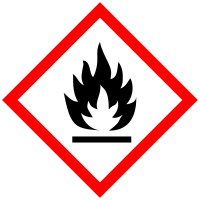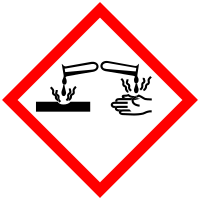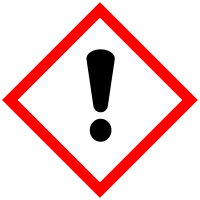
Improving Member States preparedness to face an HNS pollution of the Marine System (HNS-MS)
Isobutyl Alcohol
Description Top
| CAS number | 78-83-1 |
| UN number | 1212 |
| Chemical formula | C4H10O |
| Standard European Behaviour Classification (SEBC) | Dissolves (D) |
GESAMP Hazard profile
| A1 | A2 | B1 | B2 | C1 | C2 | C3 | D1 | D2 | D3 | E1 | E2 | E3 |
| 0 | R | 1 | 0 | 0 | 0 | 1 | 2 | 3 | NI | D | 3 |
Marine pollution Classification (MARPOL Annex II)
| Category | Description |
| Z | Noxious Liquid Substances which, if discharged into the sea from tank cleaning or deballasting operations, are deemed to present a minor hazard to either marine resources or human health and therefore justify less stringent restrictions on the quality and quantity of the discharge into the marine environment. |
Alternate names for this chemical
Alcool Isobutylique
Isobutanol
Isopropyl Carbinol
1-Hydroxymethylpropane
2-Methyl-1-Propanol
Isobutyl Alcohol
Isobutanol
Isopropyl Carbinol
1-Hydroxymethylpropane
2-Methyl-1-Propanol
Isobutyl Alcohol
Physico-chemical properties Top
| Chemical formula | C4H10O | ||
| Molar mass | 74.12 [g/mol] | ||
| Critical molar volume | 0.000274 [m³/mol] | ||
| State | Liquid at 25°C and 1 atm | ||
| Fusion temperature | -108 [°C] | ||
| Boiling temperature | 108 [°C] | ||
| Critical temperature | 547.8 [°C] | ||
| Density |
|
||
| Kinematic viscosity |
|
||
| Hydrosolubility |
|
||
| Vapour pressure |
|
||
| Critical pressure | 4295000 [Pa] | ||
| Vapour density | 2.4 | ||
| Flash point (Pensky-Martens closed cup) | 28 [°C] | ||
| Flash point (Cleveland open cup) | 32.2 [°C] | ||
| Lower explosivity limit (LEL) | 1.7 [%] | ||
| Upper explosivity limit (UEL) | 10.6 [%] | ||
| Vaporization enthalpy |
|
||
| Combustion enthalpy | 35900000 [J/Kg] | ||
| Specific heat capacity | 226.88 [J/(Kg·K)] | ||
| Combustion efficiency | 98 [%] | ||
| Mass flow rate of the combustion surface | 0.05 [Kg/(m²·s)] | ||
| Radiative fraction | 22 [%] | ||
| Henry's constant | 0.99 [mol/(m³·Pa)] |
Behaviour Top
| Log Kow | 0.76 |
| Log Koc | 1.75 |
| Hydrolysis (Half-life) | Not hydrolysable |
| Aqueous photolysis (Half-life) | Not photolysable |
| Biodegradation in estuary environment (Half-life) | 10 days |
| Biodegradation in marine environment (Half-life) | 10 days |
| Standard European Behaviour Classification (SEBC) | Dissolves (D) |
| Bioconcentration factor (BCF) | 1.97 |
Ecotoxicity Top
| Lowest median lethal concentration (LC50) on algae | 225 [mg/l] | ||
| Lowest median lethal concentration (LC50) on crustacean | 1100 [mg/l] | ||
| Lowest median lethal concentration (LC50) on fishes | 1430 [mg/l] | ||
| Highest no observed effect concentration (NOEC) on algae | 53 [mg/l] | ||
| Highest no observed effect concentration (NOEC) on crustacean | 20 [mg/l] | ||
| Assessment factor (AF) |
|
||
| Predicted No Effect Concentration (PNEC) |
|
Hazards Top



Danger
| IDLH | 1600 [ppm] |
Hazards statements
Physical
H226
Flammable liquid and vapour.
Health
H315
Causes skin irritation.
H318
Causes serious eye damage.
H335
May cause respiratory irritation.
H336
May cause drowsiness or dizziness.
Precautionary statements
Prevention
P210
Keep away from heat/sparks/open flames/hot surfaces. No smoking.
P233
Keep container tightly closed.
P240
Ground/bond container and receiving equipment.
P241
Use explosion-proof electrical/ventilating/lighting/.../equipment.
P242
Use only non-sparking tools.
P243
Take precautionary measures against static discharge.
P280
Wear protective gloves/protective clothing/eye protection/face protection.
Response
P303 + P361 + P353
IF ON SKIN (or hair): Remove/Take off immediately all contaminated clothing. Rinse skin with water/shower.
P370 + P378
In case of fire: Use ... for extinction.
Storage
P403 + P235
Store in a well-ventilated place. Keep cool.
Disposal
P501
Dispose of contents/container to ...
GESAMP Top
GESAMP Hazard profile
| A1 | A2 | B1 | B2 | C1 | C2 | C3 | D1 | D2 | D3 | E1 | E2 | E3 |
| 0 | R | 1 | 0 | 0 | 0 | 1 | 2 | 3 | NI | D | 3 |
A1: Bioaccumulation
| Rating | Description |
| 0 | No potential to bioaccumulate |
A1a:
| Rating | Description | Criteria [mg/l] |
| 0 | No potential to bioaccumulate | Log Kow < 1 |
A1b:
| Rating | Description |
| NI | No Information |
A2: Biodegradation
| Rating | Description |
| R | Readily biodegradable |
B1: Acute aquatic toxicity
| Rating | Description | Criteria [mg/l] |
| 1 | Practically non-toxic | 100 < LC/EC/IC50 ≤ 1000 |
B2: Chronic aquatic toxicity
| Rating | Description | Criteria [mg/l] |
| 0 | Negligible | NOEC > 1 |
C1: Acute oral toxicity
| Rating | Description | Criteria [mg/Kg] |
| 0 | Negligible | AOTE > 2000 |
C2: Acute dermal toxicity (skin contact)
| Rating | Description | Criteria [mg/Kg] |
| 0 | Negligible | ADTE > 2000 |
C3: Acute inhalation toxicity
| Rating | Description | Criteria [mg/l] (4 hours exposure) |
| 1 | Slight | 10 < AITE ≤ 20 |
D1: Skin irritation or corrosion
| Rating | Description | Sign | GHS category |
| 2 | Irritating | Marked erythema, Obvio | Irritant Category 2 |
D2: Eye irritation
| Rating | Description | Sign | GHS category |
| 3 | Severely irritating or corrosive | Severe conjunctoblepha | Irritant Category 1 |
D3: Long-term health effects
| Notation | Hazard endpoint | Description | GHS category |
| No Information |
E1: Tainting of seafood
| Rating | Description |
| NI | No Information |
E2: Behaviour of chemicals in the marine environment
| Rating | Description |
| D | Dissolves |
E3: Interference with the use of coastal amenities
| Rating | Interference | Description | Interpretation | Warning |
| 3 | Highly objectionable | 1 is highly acutely toxic; and/or 2 is severely irritant or corrosive to skin or eyes; and/or 3 is carcinogenic, mutagenic or reprotoxic; and/or 4 is a floater or persistent floater with associated health effects | 1 C1 and/or C2 and/or C3 = 4; and/or 2 D1 or D2 = 3, 3A, 3B, or 3C; and/or 3 D3 contains C, M or R; and/or 4 E2 = F or Fp and D3 contains Ss, Sr, T, A, N, or I | Warning issued leading to the closure of amenities |
GHS Security Information



Danger
About the project
HNS-MS is a decision-support tool that Belgian and French maritime authorities as well as coastguard stations can activate in order to forecast the drift, fate and behavior of acute marine pollution by Harmful Noxious Substances (HNS) accidentally released in the marine system.
Contact us
Copyright © 2015–2026 HNS-MS Consortium
 HNS-MS has been funded by DG-ECHO under agreement ECHO/SUB/2014/693705 and runs from 1 January 2015 to 31 March 2017.
HNS-MS has been funded by DG-ECHO under agreement ECHO/SUB/2014/693705 and runs from 1 January 2015 to 31 March 2017.